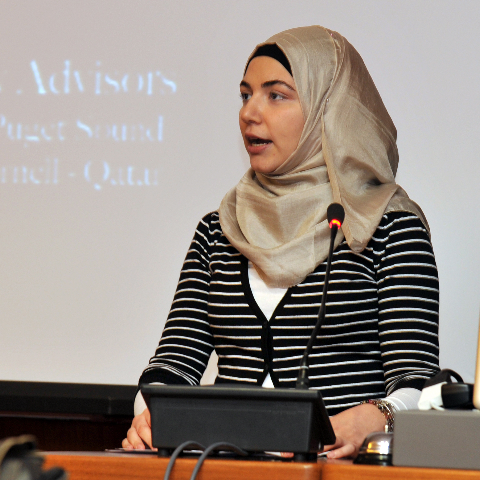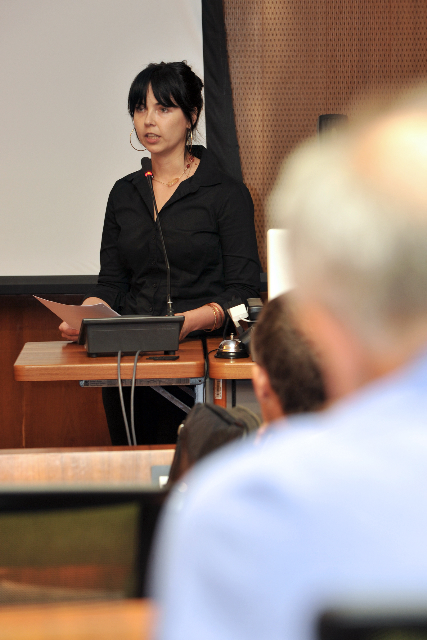Students Give Context to the Lives of Migrant Workers in Qatar
June 2010

At a public reading event to showcase student involvement in a social
research project, first-year medical student Marwa Saleh discusses the
life of 'Govinda,' a migrant worker in Doha.
According to recent figures from the Qatar Statistics Authority, approximately 85 percent of the country’s population is composed of expatriate workers. While many are skilled, middle class professionals, a majority are unskilled or semi-skilled laborers who face unusual challenges. As a social research project, two WCMC-Q medical students, three students from Qatar University and one student from Carnegie Mellon University in Qatar collected narratives to demystify the stories of migrant workers in Doha.
“Upon their arrival in the Gulf, migrants face challenges that oftentimes differ substantially from those that characterize other well-known migratory destinations,” said Andrew Gardner, a co-principal investigator of the study and assistant professor of socio-cultural anthropology at the University of Puget Sound and Qatar University. “Scholarly attention has been directed at the coupling of a vast labor brokerage system that, oftentimes, exploitatively connects men and women to jobs in the Gulf, and to the kafala, or sponsorship system, that governs and constrains their existence in the Gulf.”
With funding from the Qatar Foundation’s Undergraduate Research Experience Program and guidance of Gardner and his co-principal investigator Autumn Watts, Lecturer of Writing at WCMC-Q, the students talked to dozens of migrant workers each and captured several life stories as a result.
“We went to all of the places that you go to every day—like the parking areas where they are cleaning cars. And we spoke to so many workers,” said Marwa Saleh, a first-year medical student at WCMC-Q. “One of the biggest obstacles was getting the people to open up, because they weren’t used to being asked these questions—who are you? Where are you from? How did you get here? Do you like it here?”
Each of the six student researchers interviewed at least three workers several times, and narrowed the selection down to three based on the stories. They said that language barriers and matching schedules were the biggest logistical challenges. Yet when they had all of the information together, the challenge of translating the interviews into engaging, third-person stories with complete respect for the truth began.

Watts explains the process of writing a truthful and
interesting narrative from conversations that 'circle,
self-interrupt, double back and wander off.'
“This task is not straightforward,” said Watts. “Conversations do not lend themselves to easy distillation: they circle, self-interrupt, double back, and wander off. These conversations took place at different times on different days, recursively, to clarify or deepen understanding.”
During a recent event to highlight and share the narratives, Saleh read an excerpt from her story about a man from Nepal, to whom she assigned the alias “Govinda.” She described his family life in Nepal and how, through stories of friends who worked in the Gulf, he was drawn to the idea of making a lot of money abroad. She explored the disillusioning trials he has gone through since deciding to leave his parents and wife—dealing with a scamming ‘dalal’ employment agent, cramped living conditions and long, extremely hot hours at work. An added and heart-wrenching challenge, Govinda is currently trapped in a work contract unless he can pay 6000 QR to get out of it.
Through their interviews, students involved in the research say that their mindsets around migrant workers in Qatar changed—from sweeping generalizations of them as impoverished victims to a recognition of their individuality and agency. The student team and their faculty mentors hope that the public will experience this same change in perspective through reading the stories they have chosen to share.
“What you realize when you interview them is that some were not poor at all—some came for refuge, some were well off and went through a financial disaster at home,” said Nora Biary, a first-year medical student at WCMC-Q. “So many of the people we interviewed were highly educated. This was the biggest eye opener for me, that even if they wear the same uniform, they all come from very, very different experiences, and that’s the main message of the research project.”
The final report of the study comprises 18 stories in total, three by each student. In addition to contributions by Biary and Saleh, four students from other universities in Qatar worked on the project: Elma Atic, a recent graduate of the English literature and language program at Qatar University; Zaid Haque, a sophomore in the information systems program at Carnegie Mellon University in Qatar; and Elizabeth Jose and Yogamaya Mantha, seniors in the biomedical science program at Qatar University.
Watts and Gardner are currently in discussions with several academic presses about publishing the students’ work in a book.
Report by Emily Alp
